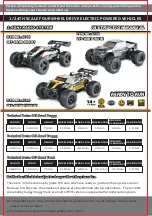
DESC410R/DEX410 Gearbox Pro-Build. | Team Durango Blog
http://www.team-durango.com/blog/2011/03/09/desc410rdex410-gearbox-pro-build/[11/10/2011 4:34:19 PM]
you need to place the
shims you’ve just
decided upon. Place the
input shaft / pinion gear
into the gearbox housing
along with the diff
you’ve just shimmed
correctly and clamp the
case halves together
with the provided screws
and spin the input
shaft. With all shims on
the crown-gear side
(where you should have
been test-fitting them)
you might find the gears
are loud and have
excess friction – so next comes choosing which side you place your shims.
You want the crown gear as close to the pinion gear as you can to get a good mesh – but you don’t want it
so close that the gearbox is notchy or excessively loud. With the example differential in the photos needing
one of each shim, you could leave the 0.2mm silver shim on the crown gear side and place the smaller
copper-coloured 0.1mm shim behind the bearing on the opposite side. This will shift the diff over by
0.1mm and effectively seperate the crown gear and pinion by the same amount. Re-assemble the gearbox
and test as before to check how smooth the gears are – a slight roughness to the action is fine but if
there’s still excessive noise and friction you can continue adjusting the shims to suit.
Above: In the example above, the perfect setting ended up with one silver shim on the Crown-gear side and one copper shim on
the moulded side.
With the differential shimming complete the last point to look
at when building your DESC410R/DEX410 is the input shaft
itself. Simply tightening the CVD-shaft onto the input shaft
and placing it into the gearbox housing could result in some
degree of movement. You can check this by clamping the
gearbox together very tightly with your fingers or screwing
the halves together – then with the unassembled CVD
attached to the input shaft, try to rock the shaft vertically up
and down (see photo). The movement, if any, will be slight –
but this is amplified inside the gearbox and will result in the
teeth of the gears having an improper contact patch which will
place excess strain on the gears.























